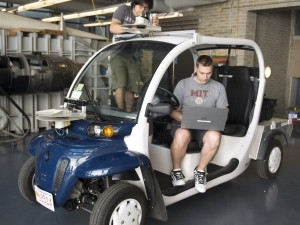
Ford Motor Company is working with the Massachusetts Institute of Technology (MIT) in the US to measure how pedestrians move in urban areas to improve public transport.
The project, which will take place at one of the university's campuses, will make use of a fleet of on-demand electric shuttles that are small enough operate on both roads and walkways, while giving enough room to pedestrians.
The shuttles are e-hailed by students using a smartphone app, similar to Uber.
LiDAR sensors and cameras are used on the vehicles to measure pedestrian flow. When an area becomes densely populated, the shuttles are routed there so they are nearby when hailed.
The project will be introduced to the campus next month.
"The on-board sensors and cameras gather pedestrian data to estimate the flow of foot traffic," says Ken Washington, VP of research and advanced engineering at Ford.
"This helps us develop efficient algorithms that bring together relevant data. It improves mobility-on-demand services, and aids ongoing pedestrian detection and mapping efforts for autonomous vehicle research."
The research will take place in the university's aeronautics and astronautics department's Aerospace Controls Lab (ACL).
ACL researches topics related to autonomous systems and control design for aircraft, spacecraft and ground vehicles.
"Through the mobility-on-demand system being developed for MIT's campus, ACL can investigate new planning and prediction algorithms in a complex but controlled environment, while simultaneously providing a testbed framework for researchers," says ACL director professor Jonathan How.
Using the data collected from the sensors and cameras, researchers study the overall pattern of how pedestrian traffic moves across campus, which helps researchers anticipate where the most demand for the shuttles will be at any given moment.
Researchers take into account other factors that affect pedestrian movement, such as weather conditions, class schedules, and how habits change in different semesters.
Ford has 29 other mobility research projects with universities worldwide.
The projects are part of Ford's broader plans to provide mobility solutions in the future when car-sharing and autonomous cars could be commonplace.
Share